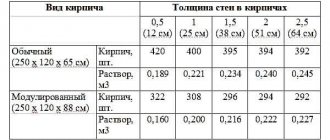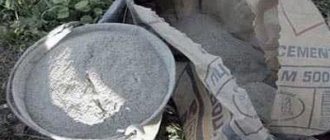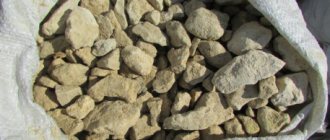How many buckets of sand are in 1 cubic meter?
One 10-liter metal bucket contains 13-15 kilograms of sand, depending on its moisture content. One cube of sand contains 100 buckets of 10 liters.
Interesting materials:
How does a quotation differ from an auction under Federal Law 44? What is the difference between a king size bed and a queen size bed? What is the difference between chicken meat and turkey meat? How does a normative legal act differ from other acts? What is the difference between Stapel and viscose? What is the difference between changing the input language and changing the keyboard layout? How to clean the oven from carbon deposits? How to clean double-sided tape from the refrigerator? How to wash dirty soles? How to remove grease from kitchen tiles?
Bulk density of cement
To determine how many kg of cement are in a 10 or 12 liter bucket, you must first find out the bulk density of the material. Usually the parameter is indicated in the quality certificate or in the instructions on the bag itself. Knowing the bulk density, it is not difficult to perform calculations.
Factors affecting the bulk density of cement:
- The shelf life of the powder - the material only from the factory shows a value of 1100 kg/m3. During the grinding process, the particles of the material receive a static charge of the same sign, and therefore repel one another. The voids are immediately filled with air. But during transportation and storage, the static charge disappears, the cement becomes denser and the indicator can even increase to 1600 kg/m3.
- Features of production technology - this factor determines the size of air voids, the size of powder fractions, etc.
- The composition of the material is limestone, slag, microsilica, etc. They reduce the cost of cement, but also the density (and strength at the same time). Only Portland cement does not contain mineral additives, and in this case the bulk density is equal to an average of 1300 kilograms per cubic meter.
To obtain the desired indicator, it is enough to multiply the bulk density by the volume of the vessel. 1300 kilograms per cubic meter is 1300 grams per cubic centimeter.
1300 grams x 10 (liters) = 13000 grams = 13 kilograms holds one 10-liter bucket of Portland cement with a density of 1300 kg/m3. Knowing the density, you can not only determine how much cement is in a 10-liter bucket, but also calculate the mass of dry powder in any container. So, for a 12-liter bucket the calculations look like this: 1300 x 12 = 15600 = 15.6 kg.
Method for calculating the number of liters of cement in a bag weighing 50 kg
As surprising as it may sound, cement is a very loose substance. Being in a powder state, it consists of microscopic particles of matter and air. Moreover, its density, depending on the “freshness”, ranges from 1,100 kg/m3 to 1,600 kg/m3.
Therefore, to simplify calculations, we assume that a volume of 1 m3 (1000 liters) contains 1,300 kg of substance. Accordingly, 1300/1000 = 1.3 kg of cement in 1 liter. Next, 50/1.3 = 38.46 liters of cement in 1 bag weighing 50 kg.
Round to the nearest whole number - we get 38.5 liters. Similarly, we calculate the number of liters of cement in 25, 30,40 and 45 kg bags, as well as the number of 10, 12, and 15 liter buckets in 25,30,40,45 and 50 kg bags. We summarize the obtained data in a table.
| Bag of cement, kg | Amount of cement, l | Number of buckets with a capacity of 10 l | Number of buckets with a capacity of 12 l | Number of buckets with a capacity of 15 l |
| 25 | 19 | 1+9 liters | 1+7 liters | 1+4 liters |
| 30 | 23 | 2+3 liters | 1+11 liters | 1+8 liters |
| 40 | 30,8 | 3+0.8 liters | 2+6.8 liters | 2+0.8 liters |
| 45 | 34,6 | 3+4.6 liters | 2+10.6 liters | 2+4.6 liters |
| 50 | 38,5 | 3+8.5 liters | 3+2.5 liters | 2+8.5 liters |
To summarize, it should be noted that the above data are averages. That is, in each specific case they can differ both up and down.
To accurately calculate the number of liters of cement in a bag, it is necessary to use state-certified laboratory measuring vessels and laboratory scales. At the same time, for private construction the given data are quite acceptable and have been tested in practice more than once.
Source
What to consider when calculating
To calculate how many bags of cement are in a cube of concrete, you need to take into account the following parameters:
- design strength of concrete;
- brand of cement;
- packaging size;
- aggregate fraction;
- proportion of components.
The composition for preparing the concrete mixture is regulated by Building Codes and Rules 5.01.23-83. The document indicates the recommended grades of Portland cement to obtain a monolith with the required characteristics.
For individual construction, concrete is used:
- M100 - for installing cushions under foundations,
- M150 - pouring paths, blind areas, floor screeds, bases for sheds, garages, gazebos, installing curbs, fence posts;
- M200 - production of monolithic foundations, lintels, floor slabs, columns and walls.
In accordance with the brand of the monolith, the consumption of the binder is normalized.
Cement brand
The main characteristic that needs to be taken into account when purchasing is the brand of cement. It determines the strength characteristics of the binder component. The higher it is, the less consumption of this material.
In individual construction, the most used are PC grades 350-500.
Areas of application of Portland cement:
- M200, M300 - finishing work;
- M400, M500 - monolithic foundations, walls and other building structures.
You need to pay attention to freshness - strength decreases with long-term storage. According to GOST rules, the shelf life of PC is 1 year from the date of manufacture.
Important! The rule that is used when purchasing a binder is that its grade should be one and a half to two times higher than the corresponding characteristics of the concrete mixture. For concrete M100 you need to take cement M200, etc.
Fillers
Cement consumption per cubic meter of concrete depends on the size of coarse aggregate - crushed stone, gravel and fine aggregate - sand. The standards provide for the use of increasing and decreasing coefficients when fraction sizes deviate upward or downward.
If the size of the crushed stone is less than 20 mm, the amount of binder is increased by 10%, otherwise it is reduced by 5-10%.
The sand fineness modulus is taken into account:
- if it does not exceed 1.5, the PC consumption is increased by 12%;
- up to 2 - by 5%.
Cooperation with AlfaCem
With the group, it will become easier not only to learn about the correct preparation of compounds and how they are used to achieve optimal strength. We are ready to deliver dry powder building materials throughout Moscow and the Moscow region. All products comply with GOST and have an accompanying certificate issued in accordance with technical standards.
Leave a request or call us directly (section “Contacts”) to discuss the details of the order. A competent manager will draw up an adequate estimate, taking into account the optimal ratio of building materials. You don’t have to independently determine how much a bag of cement actually weighs. It is enough to select its type, having previously described the factors that potentially influence the future construction.
By minimizing consumption, you will save significantly, because we offer extremely competitive prices. The cost may become even lower due to discounts and bonuses. We will be grateful to every client who writes positive reviews about the company or brings constructive criticism to us. This helps to significantly improve service. Waiting for you!
© Online store of building materials "AlfaCem" 2001–2021
How much does a liter of water weigh - a little history
At different times, the answer to this question was different. But the world’s minute-to-minute water consumption is extremely high! Therefore, it was necessary to make a general decision regarding the measurement of the mass of the liquid. So, in 1964, during the international conference on weights and measures, a unit was approved that designated the volume of 1 dm 3 of water - liter.
However, this unit means volume rather than weight. In this case, the weight can be completely different - for example, a liter of water will be much heavier than a liter of gasoline due to its higher density.
In 1901, the third international conference on weights and measures decided to denote a liter as the volume of 1 kg of water at a temperature of 3.98 ° C and an atmospheric pressure of 760 mm Hg. The main difference in the designation of a liter was that in 1901 this unit was considered the volume of a kilogram, and in 1964 - only the volume, while the weight of the substance could be different.
So in the period 1901 - 1964. the weight of a liter of water was equal to one kilogram, however, subject to the above indicators of temperature and atmospheric pressure. To maintain this equality, it is also necessary that the water be clean. After all, ordinary drinking water contains salts that have different effects on its density. Is there a difference between swimming in a fresh lake and a salt lake? Of course, it is unlikely that you will drown in the latter. So in order for a liter of water to be equal to a kilogram, the liquid must be distilled, obtained by evaporation and condensation of steam.
Average bulk density of components and materials for concrete
Despite the simplicity of performing calculations using the method indicated above, it is not always possible to use it. The thing is that the bulk density of the material can change and is not always known exactly.
And if several components are used at once, then finding out the bulk density and converting the indicator into kilograms can become a problem without knowledge or tables. Therefore, the main values are indicated below.
Average bulk density of different materials:
- Loose cement – 1100-1200 kg/m3
- Compacted cement – 1500-1600 kg/m3
- The average for cement is 1300 kg/m3
- Average for sand -1400 kg/m3
- Slag crushed stone – 800 kg/m3
- Fine gravel – 1700 kg/m3
These are average figures; to make accurate calculations, it is better to find out the parameters of specific building materials. Then it will be possible to most accurately determine how many kilograms of cement, crushed stone, sand are in one 10/12-liter bucket.
Mass in different volumes
As a rule, ordinary buckets are used in the process of preparing concrete mortar. Therefore, it becomes most relevant to determine how many kilograms of cement are in a 10-liter bucket (or 12-liter). But if there are no buckets at hand, and the proportions are indicated in this particular container, you can perform the calculation, ignoring the container, and simply determining the kilograms and starting from the mass in the bag.
To find out how many kg of cement are in a 10-liter bucket, just multiply the density by the volume. For ordinary cement, the density is 1300 kg/m3 (or 1300 g/cm3). 1300 x 10 (12) = 13 (15.6) kilograms. In order not to get confused in the calculations and not have to perform them over and over again, you can use ready-made data.
How many kilograms of components are in a 10-liter bucket:
- Loose cement – 11-12 kilograms
- Compacted cement – 15-16 kilograms
- The average for cement is 13 kilograms
- The average for sand is 14 kilograms
- Slag crushed stone – 8 kilograms
- Fine gravel – 17 kilograms
To find out how many buckets there are in 1 bag of cement, simply divide the mass of the bag by the mass of the dry component that fits in the bucket (the average is 13 kg, which means cement in a 50 kg bag: 50 kg / 13 = 3.84 buckets).
Method for calculating the number of liters of cement for a 50 kg bag
Cement is a fairly loose mixture, so its density may change over time. Thus, the density of cement is in the range from 1100 to 1600 kg/m3. To simplify calculations, they usually take the figure of 1300 kg/m3. This means that 1,300 kilograms of powder can be placed in one cubic container (1000 liters).
This means that one liter contains 1300 / 1000 = 1.3 kilograms of cement. Next, we calculate how many liters of cement a 50 kg bag contains: 50 / 1.3 = 38.46 = 38.5 liters of cement a standard bag weighing 50 kilograms holds. Accordingly, a 25 kg bag contains 38.46 / 2 (or 25 / 1.3) = 19.23 = 19.5 liters of cement. A 40 kg bag contains 40 / 1.3 = 30.77 = 31 liters.
In the same way, you can calculate the volume of any bag.
Number of buckets of cement for bags of 20, 25 and 50 kg
To determine the number of buckets in various cement delivery containers, you can perform simple calculations. Here you need to take the above values.
How many 10-liter buckets of cement in bags - calculation:
- The density of cement is 1300 kg/m3 (g/cm3).
- Determination of the weight of cement in one 10-liter bucket is 1300 grams (as much is contained in one liter) x 10 liters = 13 kilograms of cement in one 10-liter bucket.
- A 20 kg bag contains 20 / 13 = 1.53 buckets of cement.
- A bag weighing 25 kilograms contains 1.92 buckets.
- A 50 kg bag contains 3.84 buckets of cement.
How many 12-liter buckets are in bags - calculation:
- In one bucket – 1300 x 12 = 15.6 kg of cement.
- In a bag of 20 kg - 20 / 15.6 = 1.28.
- In a bag of 25 kg - 1.6.
- 50 kg bag – 3.2.
Number of kg of cement in 10 and 12 liter buckets
One 10-liter bucket holds 13 kilograms of cement, a 12-liter bucket holds 15.6 kilograms. These values are taken with the condition that the cement density is 1300 kg/m3. But this parameter does not always correspond to exactly this figure, so you can check yourself before starting the calculations.
To do this, choose any container with a volume equal to one liter. It is weighed and the value is recorded in kilograms. Then cement is poured into the container and weighed again. Next, subtract the weight of the container itself from the obtained value and get a figure showing how many kilograms of dry cement 1 liter holds.
This value is multiplied by 10 or 12 liters (depending on the volume of the bucket) and the weight in the bucket is obtained. Next, the number of kilograms in the bag is divided by the resulting number and they find out how many buckets one bag can hold.
Knowing how many kilograms of cement fit in a bucket, you can calculate a more or less exact number of bags of material that will be needed to complete the work. Accurate calculations are the key to saving money, time and effort.











